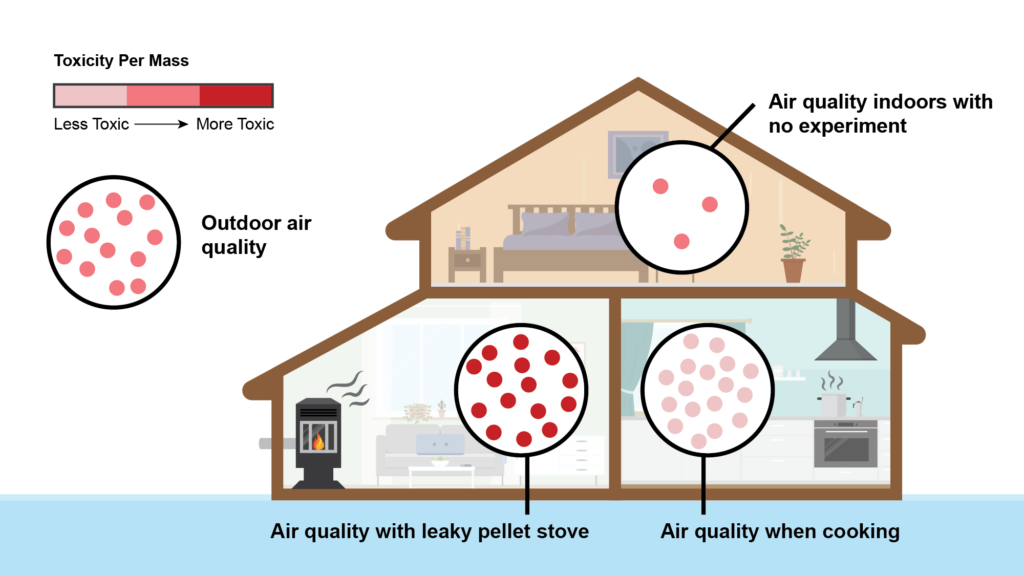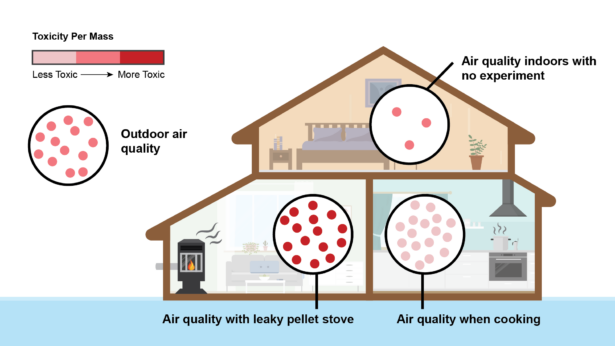By Peter DeCarlo, Rodney Weber, and Bill Simpson
Fairbanks and North Pole residents spend a lot of time indoors during the winter. Therefore, it makes sense that the first question you often hear when talking about air quality is, “What is the air like inside my house?”
To address this question, the Fairbanks Winter Air Study rented a house, filled its garage with air-sniffing instruments and measured air pollutants outside and inside the house. After six weeks of measurements, we can start to answer this important question.
We chose a typical home near the Hamilton Acres area, which was affected by local residential heating, including wood, oil, and gas, as well as by other air pollution sources from the downtown core. The Cold Climate Housing Research Center studied the air tightness of the house and estimated the energy rating to be between 3-star+ and 4-star. As with most of our houses, the windows were closed for the full study period in January and February 2022. The house was unoccupied most of the time so as to be able to isolate infiltration from people’s activities indoors.
The best air quality indoors happened when we weren’t doing anything. That means no cooking or supplementing heat with a pellet stove. Without any indoor activities, the concentration of particulate matter, PM, indoors followed the ups and downs of outdoor PM concentrations but was only about 20% of the outdoor concentrations in this research house. Infiltration of air through cracks filters the air and particles also deposit indoors, reducing the PM concentrations. Because lower PM concentrations are correlated with better health outcomes, this result is healthy news.

That picture changed a bit when we started doing some common indoor activities like cooking or running the pellet stove. Chefs know that cooking can make a lot of smoke, and frying chicken breasts was one way we tested to see how indoor air quality is affected. When we cooked, we found that particle concentrations indoors became larger than concentrations outdoors. We also found that the composition of these particles was much richer in organic molecules (probably the fats from frying) and are studying how toxic these particles were. Preliminary results indicate that the cooking particles that did not involve burning or charring are less toxic than outdoor air pollution particles.
We also found that the pellet stove had a small leak in the exhaust and that wood-smoke particles were coming into the house. This raised the PM concentration to levels comparable to the outdoors. The preliminary results indicate that these particles were more toxic than those outside and cooking particles, in line with literature about wood smoke toxicity.
These results on particles indoors and out at the house are just a small part of what we measured. We also measured gas exchange of carbon dioxide, methane and reactive gases and volatile organic compounds and many more air pollutants in order to study their interactions. We look forward to sharing those results when we complete that analysis.
These results show that the air tightness of a house can help protect the residents from outdoor particulate matter pollution but that the same barrier can trap indoor pollution and make indoor air worse than outside depending on the type and amount of indoor emissions and HVAC system. It is not just the activities we carried out in our study that can affect indoor air but also indoor sources like radon from under the house, solvents stored in the house and activities such as smoking that can create bad indoor air. Air purifiers, HVAC systems, and vent fans can help to improve indoor air quality and provide healthier air to breathe.
Peter DeCarlo of Johns Hopkins University and Rodney Weber of Georgia Institute of Technology are experts who visited Fairbanks for this study last winter. Bill Simpson is a University of Alaska Fairbanks air quality researcher who hosted the study. This work was funded by the National Science Foundation.


